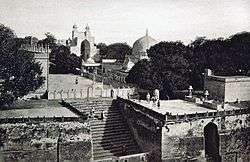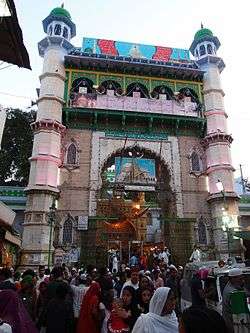Ajmer Sharif Dargah


The dargah of Moinuddin Chishti ( Gharib Nawaz -Benefactor of the Poor), known as Ajmer Sharif Dargah or Ajmer Sharif, is an international waqf, an Islamic mortmain managed by the "Dargah Khwaja Saheb Act, 1955" of the government of India. Ajmer Sharif Dargah is 2km away from the main central Ajmer Railway station and situated at the foot of the Taragarh hill, and consists of several white marble buildings arranged around two courtyards, including a massive gate donated by the Nizam of Hyderabad and the Akbari Mosque, built by the Mughal emperor Shah Jahan. It contains the domed tomb of the saint. Akbar and his queen used to come here by foot on pilgrimage from Agra every year in observance of a vow when he prayed for a son. The large pillars called "Kose ('Mile') Minar", erected at intervals of two miles (3 km) along the entire way between Agra and Ajmer mark the places where the royal pilgrims halted every day. It has been estimated that around 150,000 pilgrims visit the site every day.
The Shrine
The main gate to the shrine is the Nizam Gate, followed by the Shahjahani Gate, erected by the Mughal emperor Shah Jahan. In turn it is followed by the Buland Darwaza,[1] built by Sultan Mahmood Khilji,[2] upon which is hoisted the urs flag, marking the beginning of the death anniversary rituals.[3] The urs for Moinuddin Chishti is celebrated every year on the 6th and 7th of Rajab.[4]
Trust
The dargah (shrine) of Khwaja Moinuddin Chishti is an international wakf (endowment), managed under The Dargah Khwaja Saheb Act, 1955 of Government of India. The Dargah Committee, appointed by the Government, takes care of the maintenance of the shrine, and runs charitable institutions like dispensaries, and guest houses for the devotees but do not care take the rituals of the main shrine(Mazar sharif/Astana e Alia) which is under the Custody of inherited Priests known as Khadims. .[5]
Dewan of the Dargah
Dewan Syed Zainul Abedin is the direct descendant in the 22nd generation of Khwaja Moinuddin Chishti. Meanwhile, according to the Supreme Court of India he is the Hereditary Sajjadanashin Spiritual Head of the shrine of Ajmer Dargah. On the other hand, in the aspect of genealogical lineage (family tree); presently he is the most direct descendant of Khawaja Moinuddin Chishti.[6] [7][8][9][10] He is the successor of Khwaja Gareeb Nawaz,[6][7][8][9][10]
See also
- http://www.khwajagharibnawazindia.com
- Hazrat Turabul Haq Dargah
- Dewan Syed Zainul Abedin
- Prophet's Day
- Ahmed Ullah Maizbhanderi
- Baba Bhanderi
- Salekur Rahman Rahe Bhanderi
Notes and references
- ↑ This "high gate" or "buland darwaza" should not be confused with Akbar's more famous Buland Darwaza in Fatehpur Sikri.
- ↑ Sultan Mahmood Khilji II (Shihab-ud-Din Mahmud Shah II) ruled Malwa from 1510 to 1531.
- ↑ "Historical Monuments". Mission Sarkar Gharib Nawaz. Archived from the original on 29 January 2015.
- ↑ "Preparations for Urs in full swing at Ajmer dargah". The Times of India. 13 May 2011. Archived from the original on 26 May 2014.
- ↑ Mayank Austen Soofi. "The Sufi Solution". Live Mint. Retrieved 18 February 2012.
- 1 2 AIR 1987,. "Page: 2213". Supreme Court.
- 1 2 AIR 1961,. "Page: 1402". Supreme Court.
- 1 2 AIR 1938,. "Page: 71". Privy Council.
- 1 2 AIR 1947,. "Page: 01". Privy Council.
- 1 2 RLW. "Page: 69 and 317". Rajasthan High Court.
Coordinates: 26°27′26″N 74°37′38″E / 26.4572829°N 74.6271856°E
